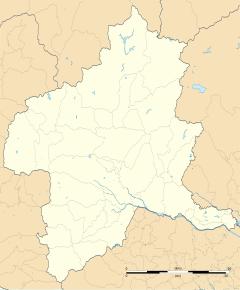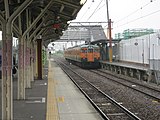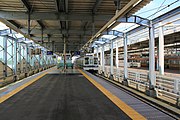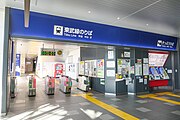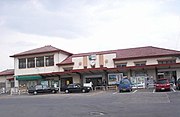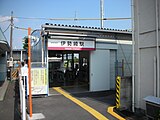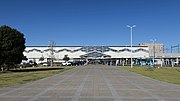Isesaki Station
TI25 Isesaki Station 伊勢崎駅 | |||||||||||||||||||||||||
|---|---|---|---|---|---|---|---|---|---|---|---|---|---|---|---|---|---|---|---|---|---|---|---|---|---|
 Isesaki Station, June 2010 | |||||||||||||||||||||||||
| General information | |||||||||||||||||||||||||
| Location | 3-1 Kuruwa-cho, Isesaki-shi, Gunma-ken 372-0055 Japan | ||||||||||||||||||||||||
| Coordinates | 36°19′37″N 139°11′36″E / 36.3269°N 139.1933056°E | ||||||||||||||||||||||||
| Operated by | |||||||||||||||||||||||||
| Line(s) | |||||||||||||||||||||||||
| Distance | 69.1 km (42.9 mi) from Oyama (JR East) 114.5 km (71.1 mi) from Asakusa (Tobu) | ||||||||||||||||||||||||
| Platforms | 2 island platforms (JR East) 1 island (Tobu) | ||||||||||||||||||||||||
| Other information | |||||||||||||||||||||||||
| Status | Staffed | ||||||||||||||||||||||||
| Station code | TN-25 (Tobu) | ||||||||||||||||||||||||
| History | |||||||||||||||||||||||||
| Opened | 20 November 1889 | ||||||||||||||||||||||||
| Passengers | |||||||||||||||||||||||||
| FY2021 | 4,920 daily (JR East) 5,612 (Tobu) | ||||||||||||||||||||||||
| Services | |||||||||||||||||||||||||
| |||||||||||||||||||||||||
| |||||||||||||||||||||||||
Isesaki Station (伊勢崎駅, Isesaki-eki) is a junction passenger railway station in the city of Isesaki, Gunma Prefecture, Japan, jointly operated by East Japan Railway Company (JR East) and the private railway operator Tōbu Railway.
Lines
[edit]Isesaki Station is a station on the JR East Ryōmō Line, and is located 69.1 km (42.9 mi) from the terminus of the line at Oyama, and 22.6 km (14.0 mi) from Takasaki. The preceding station of Kunisada is 5.8 km (3.6 mi) away and the following station of Komagata is 5.8 km (3.6 mi) away. It also forms the northern terminus of the Tōbu Isesaki Line, and is 114.5 km (71.1 mi) from the starting point of the line at Asakusa in Tokyo. The preceding station of Shin-Isesaki is 1.2 km (0.75 mi) away.
Station layout
[edit]JR Station
[edit]Source:[1]
The JR East station consists of two elevated island platforms serving four tracks, with the station building underneath. The station has many accessibility features such as escalator, elevators, Mobility scooter access, wheelchair-accessible bathroom, and a Braille Fare table.[2]
| 1 2 |
■ Ryōmō Line | for Maebashi,and Takasaki |
| 3 4 |
for Kiryū and Oyama |
-
JR East Platforms 1 and 2 November 2021
-
JR East Platforms 3 and 4 November 2011
-
Platforms before Elevation work August 2008
Tōbu Station
[edit]The Tōbu Station consists of one elevated island platform serving two tracks, with the station building located underneath.[3]
Platforms
[edit]| 1 2 |
■ Tōbu Isesaki Line | for Ōta, Ashikagashi, and Asakusa |
-
Tobu Platforms June 2020
-
Tobu Station Ticket Gate
History
[edit]Isesaki Station was opened on 20 November 1889 for Ryōmō Line service.[4] On 13 July 1910, the Tobu Railway station opened.[5] The station section servicing the Ryōmō Line was absorbed into the JR East network upon the privatization of the Japanese National Railways (JNR) on 1 April 1987.
The JR East station started accepting Suica cards on 18 November 2001, while the Tōbu Station started accepting Pasmo cards on 18 March 2007.[6]
In May 2010, the construction work to elevate the Ryōmō Line platforms in Isesaki Station was completed. From 17 March 2012, station numbering was introduced on all Tōbu lines, with Isesaki Station becoming "TI-25".[7] On 19 October 2013, roughly three years after the completion of the construction work surrounding the Ryōmō Line, the Tobu Isesaki Line elevation work was completed.[8]
The Midori no Madoguchi ticket office was closed on 30 November 2021[9].
-
Former station building (May 2007)
-
Temporary station building December 2012
-
Isesaki Station south entrance November 2020
Passenger statistics
[edit]In fiscal 2021, the Tōbu station was used by an average of 5,612 passengers daily.[Tobu 1] The JR East station was used by 4,920 passengers daily (boarding passengers only).[JR 1]
Below is table containing the passenger statistics since the year 2000:
| Passenger statistics | ||||||||
|---|---|---|---|---|---|---|---|---|
| Year | Average Daily
Boarding Passengers (JR East) |
Average Daily
Passengers (Tobu) |
Year | Average Daily
Boarding Passengers (JR East) |
Average Daily
Passengers (Tobu) |
Year | Average Daily
Boarding Passengers (JR East) |
Average Daily
Passengers (Tobu) |
| 2000 | 5,144[JR 2] | 2010 | 5,118[JR 3] | 5,607[Tobu 2] | 2020 | 4,418[JR 4] | 5,038 | |
| 2001 | 4,966[JR 5] | 2011 | 5,193[JR 6] | 5,690[Tobu 3] | 2021 | 4,920[JR 1] | 5,612[Tobu 1] | |
| 2002 | 4,844[JR 7] | 2012 | 5,406[JR 8] | 5,998[Tobu 4] | ||||
| 2003 | 4,929[JR 9] | 2013 | 5,608[JR 10] | 6,206[Tobu 5] | ||||
| 2004 | 4,923[JR 11] | 2014 | 5,595[JR 12] | 6,115[Tobu 6] | ||||
| 2005 | 4,833[JR 13] | 2015 | 5,808[JR 14] | 6,367[Tobu 7] | ||||
| 2006 | 4,792[JR 15] | 5,333[Tobu 8] | 2016 | 5,825[JR 16] | 6,561[Tobu 9] | |||
| 2007 | 4,793[JR 17] | 5,337[Tobu 10] | 2017 | 5,987[JR 18] | 6,738[Tobu 11] | |||
| 2008 | 4,931[JR 19] | 5,444[Tobu 12] | 2018 | 6,121[JR 20] | 7,003[Tobu 13] | |||
| 2009 | 4,909[JR 21] | 5,372[Tobu 14] | 2019 | 6,058[JR 22] | 6,923[Tobu 15] | |||
Surrounding area
[edit]- Isesaki Post Office
- Isesaki Shrine
- Gunma Bank Isesaki Branch
- Ashikaga Bank Isesaki Branch
- Towa Bank Isesaki Branch
Bus routes
[edit]- SILK LINER (Nippon Chuo Bus)
- Sendai Liner (Nippon Chuo Bus)
- Shinjuku-Honjo/Isesaki Line (JR Bus Kanto)
- For Shinjuku Station
- Kokusai Juo Bus
- Gunma Chuo Bus
- For Gunma Prefectural Women's University (Runs on weekdays only)
See also
[edit]References
[edit]- ^ "JR東日本:駅構内図(伊勢崎駅)". JR東日本:東日本旅客鉄道株式会社 (in Japanese). Retrieved 29 March 2023.
- ^ "駅の情報(伊勢崎駅):JR東日本". JR東日本:東日本旅客鉄道株式会社 (in Japanese). Retrieved 29 March 2023.
- ^ "伊勢崎駅 構内マップ". www.tobu.co.jp (in Japanese). Retrieved 29 March 2023.
- ^ 日本国有鉄道停車場一覧 [JNR Station Directory]. Japan: Japanese National Railways. 1985. p. 110. ISBN 4-533-00503-9.
- ^ Terada, Hirokazu (19 January 2013). データブック日本の私鉄 [Databook: Japan's Private Railways]. Japan: Neko Publishing. p. 222. ISBN 978-4-7770-1336-4.
- ^ "会社の沿革2001年~2010年|東武鉄道公式サイト". www.tobu.co.jp (in Japanese). Retrieved 29 March 2023.
- ^ 「東武スカイツリーライン」誕生! あわせて駅ナンバリングを導入し、よりわかりやすくご案内します [Tobu Sky Tree Line created! Station numbering to be introduced at same time] (PDF). Tobu News (in Japanese). Tobu Railway. 9 February 2012. Archived from the original (PDF) on 8 August 2012. Retrieved 21 October 2013.
- ^ 東武伊勢崎線 伊勢崎—新伊勢崎周辺が高架化される [Tobu Isesaki Line section between Isesaki and Shin-Isesaki elevated]. Japan Railfan Magazine Online (in Japanese). Japan: Koyusha Co., Ltd. 21 October 2013. Retrieved 21 October 2013.
- ^ "『伊勢崎駅「みどりの窓口」は、2022-12-15をもって営業終了します』". さんちゃんの駅ブログ (in Japanese). Retrieved 30 March 2023.
JR East Passenger statistics
[edit]- ^ a b "各駅の乗車人員 2021年度 ベスト100以下(3)|企業サイト:JR東日本". JR東日本:東日本旅客鉄道株式会社 (in Japanese). Retrieved 29 March 2023.
- ^ "JR東日本:各駅の乗車人員(2000年度)". www.jreast.co.jp. Retrieved 29 March 2023.
- ^ "JR東日本:各駅の乗車人員(2010年度)". www.jreast.co.jp. Retrieved 29 March 2023.
- ^ "各駅の乗車人員 2020年度 ベスト100以下(3)|企業サイト:JR東日本". JR東日本:東日本旅客鉄道株式会社 (in Japanese). Retrieved 29 March 2023.
- ^ "JR東日本:各駅の乗車人員(2001年度)". www.jreast.co.jp. Retrieved 29 March 2023.
- ^ "JR東日本:各駅の乗車人員(2011年度)". www.jreast.co.jp. Retrieved 29 March 2023.
- ^ "JR東日本:各駅の乗車人員(2002年度)". www.jreast.co.jp. Retrieved 29 March 2023.
- ^ "JR東日本:各駅の乗車人員(2012年度)". www.jreast.co.jp. Retrieved 29 March 2023.
- ^ "JR東日本:各駅の乗車人員(2003年度)". www.jreast.co.jp. Retrieved 29 March 2023.
- ^ "各駅の乗車人員 2013年度 ベスト100以外(3):JR東日本". www.jreast.co.jp. Retrieved 29 March 2023.
- ^ "JR東日本:各駅の乗車人員(2004年度)". www.jreast.co.jp. Retrieved 29 March 2023.
- ^ "各駅の乗車人員 2014年度 ベスト100以外(3):JR東日本". www.jreast.co.jp. Retrieved 29 March 2023.
- ^ "JR東日本:各駅の乗車人員(2005年度)". www.jreast.co.jp. Retrieved 29 March 2023.
- ^ "各駅の乗車人員 2015年度 ベスト100以外(3):JR東日本". www.jreast.co.jp. Retrieved 29 March 2023.
- ^ "JR東日本:各駅の乗車人員(2006年度)". www.jreast.co.jp. Retrieved 29 March 2023.
- ^ "各駅の乗車人員 2016年度 ベスト100以外(3):JR東日本". www.jreast.co.jp. Retrieved 29 March 2023.
- ^ "JR東日本:各駅の乗車人員(2007年度)". www.jreast.co.jp. Retrieved 29 March 2023.
- ^ "各駅の乗車人員 2017年度 ベスト100以外(3):JR東日本". www.jreast.co.jp. Retrieved 29 March 2023.
- ^ "JR東日本:各駅の乗車人員(2008年度)". www.jreast.co.jp. Retrieved 29 March 2023.
- ^ "各駅の乗車人員 2018年度 ベスト100以外(3):JR東日本". www.jreast.co.jp. Retrieved 29 March 2023.
- ^ "JR東日本:各駅の乗車人員(2009年度)". www.jreast.co.jp. Retrieved 29 March 2023.
- ^ "各駅の乗車人員 2019年度 ベスト100以外(3):JR東日本". www.jreast.co.jp. Retrieved 29 March 2023.
Tobu Passenger statistics
[edit]- ^ a b "駅情報(乗降人員)|東武鉄道公式サイト". www.tobu.co.jp (in Japanese). Retrieved 29 March 2023.
- ^ "東武鉄道" (PDF). 関東交通広告協議会. p. 18. Archived from the original (PDF) on 10 March 2019. Retrieved 29 March 2023.
- ^ "東武鉄道" (PDF). 関東交通広告協議会. p. 18. Archived from the original (PDF) on 10 March 2019. Retrieved 29 March 2023.
- ^ "東武鉄道" (PDF). 関東交通広告協議会. p. 18. Archived from the original (PDF) on 10 March 2019. Retrieved 29 March 2023.
- ^ "東武鉄道" (PDF). 関東交通広告協議会. p. 17. Archived from the original (PDF) on 20 March 2019. Retrieved 29 March 2023.
- ^ "東武鉄道" (PDF). 関東交通広告協議会. p. 17. Archived from the original (PDF) on 10 March 2019. Retrieved 29 March 2023.
- ^ "東武鉄道" (PDF). 関東交通広告協議会. p. 17. Archived from the original (PDF) on 10 March 2019. Retrieved 29 March 2023.
- ^ "東武鉄道" (PDF). 関東交通広告協議会. p. 17. Archived from the original (PDF) on 10 March 2019. Retrieved 29 March 2023.
- ^ "東武鉄道" (PDF). 関東交通広告協議会. p. 17. Archived from the original (PDF) on 10 March 2019. Retrieved 29 March 2023.
- ^ "東武鉄道" (PDF). 関東交通広告協議会. p. 17. Archived from the original (PDF) on 10 March 2019. Retrieved 29 March 2023.
- ^ "東武鉄道" (PDF). 関東交通広告協議会. p. 17. Archived from the original (PDF) on 8 July 2019. Retrieved 29 March 2023.
- ^ "東武鉄道" (PDF). 関東交通広告協議会. p. 18. Archived from the original (PDF) on 10 March 2019. Retrieved 29 March 2023.
- ^ "東武鉄道" (PDF). 関東交通広告協議会. p. 17. Archived from the original (PDF) on 9 February 2021. Retrieved 29 March 2023.
- ^ "東武鉄道" (PDF). 関東交通広告協議会. p. 18. Archived from the original (PDF) on 10 March 2019. Retrieved 29 March 2023.
- ^ "東武鉄道" (PDF). 関東交通広告協議会. p. 17. Archived from the original (PDF) on 14 February 2021. Retrieved 29 March 2023.
External links
[edit]![]() Media related to Isesaki Station at Wikimedia Commons
Media related to Isesaki Station at Wikimedia Commons
- Isesaki Station (JR East) (in Japanese)
- Isesaki Station Archived 23 February 2012 at the Wayback Machine (Tobu Railway) (in Japanese)

